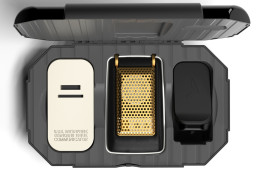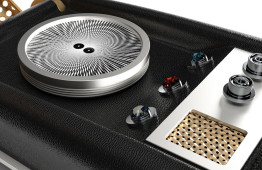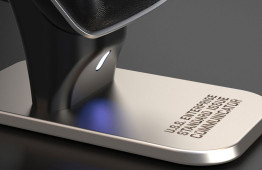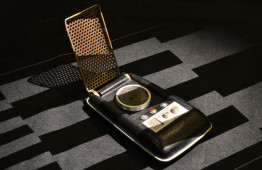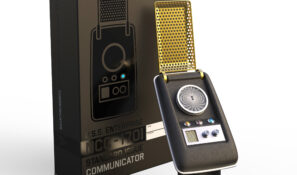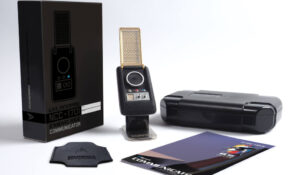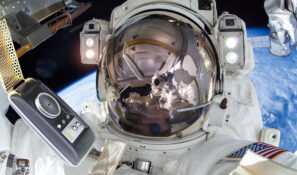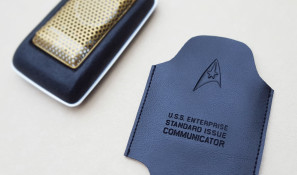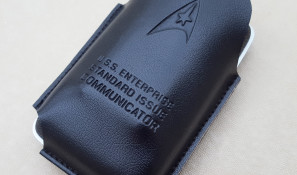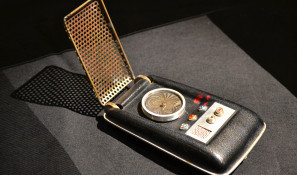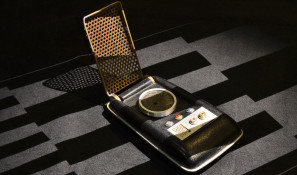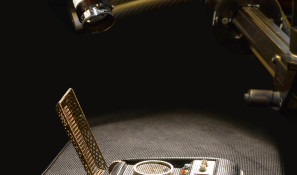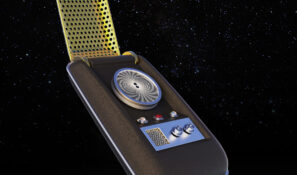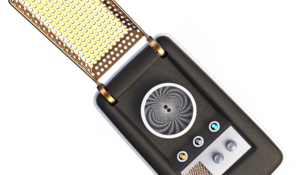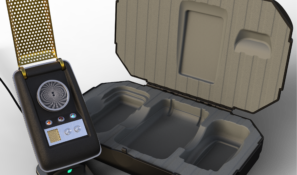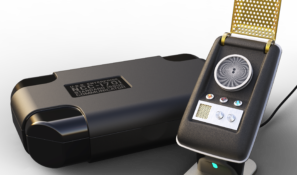Star Trek TM: The Original Series
Bluetooth® Communicator Prop Replica
The Wand Company is proud to present our Star Trek: The Original Series Bluetooth Communicator. This exceptionally accurate and highly detailed working replica was revealed on ThinkGeek’s booth at San Diego Comic-Con in July 2015.
Our new Communicator is an advanced Bluetooth enabled speakerphone that is compatible with all Bluetooth enabled communications equipment worldwide, such as mobile phones and music players.
Highly accurate: Created from 3D scans of the last known hero prop
Fully functional: Easy to pair with any Bluetooth compatible mobile phone
Authentic function: Use the classic flip action to answer calls
High quality: Die-cast zinc, CNC machined aluminium, iridescent coated jewels
Contactless charging: Built-in lithium polymer battery
Immersive play features: 17 new authentic voice clips and 3 Original Series Communicator sound FX
Gorgeous transit case: Moulded foam lined transit case and leatherette pouch
beautifully presented
The Communicator prop replica is protected from damage and kept in pristine condition (when not on display) in a high quality, moulded-foam-lined presentation case. Manufactured in hard-wearing engineering-grade ABS, the case is also designed to stack as if supplied from the original Enterprise. When on the move, a leatherette pouch protects it from scuffing.
quality materials
High-quality materials are brought together to create an exceptionally well-finished Communicator replica that looks and feels like it means business: CNC-machined aluminium; nickel-plated die-cast zinc; punched, pressed and welded steel; thermoplastic polyurethane rubber; ABS plastic with a digitally created texture.
the ultimate collectible
Whether you have just discovered Star Trek or have been hooked since you were a kid, this Communicator is something that you just have to own. Researched, designed and built with fanatical attention to detail, the simplicity of its embossed, die-cast, magnetic, wireless charging stand presents and charges this iconic piece with style.
the fantasy made real
Designed from the first 3D structured light scans of the last known hero screen-used Communicator prop, this amazing replica boasts a host of exciting features such as a silent rotating moiré pattern, AB-coated iridescent jewels and, authentic voice clips arranged in sentence fragments for immersive play, while also being a fully-functional Bluetooth enabled handset.
The Wand Company’s attention to detail combined with state-of-the-art technology brings the fantasy to life
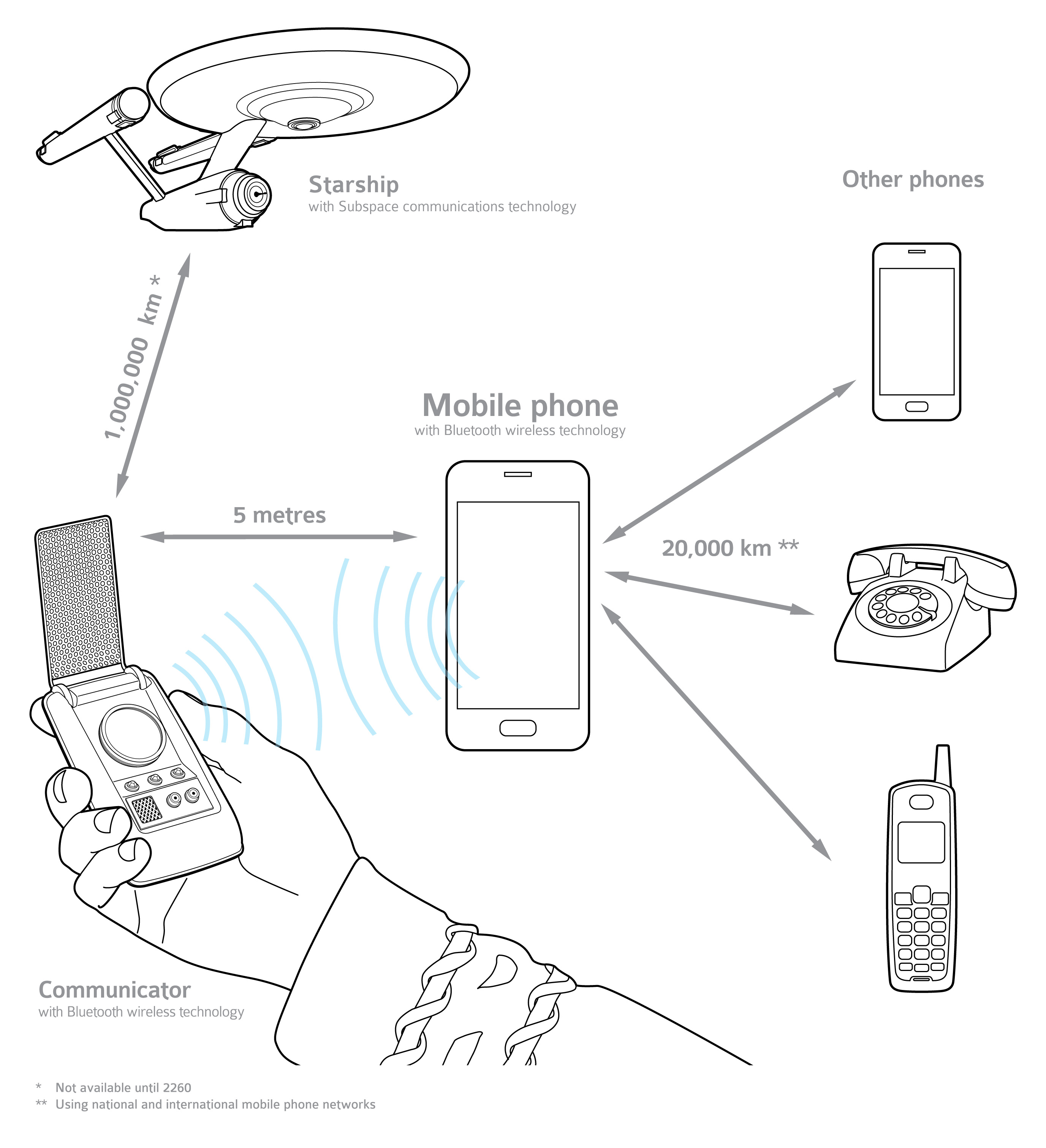
This Original Series Bluetooth Communicator is not a toy: it is an advanced, Bluetooth wireless technology enabled communications device, designed to pair with a mobile phone and thus permit near instantaneous person-to-person communication at a considerable distance. When paired with a device capable of streaming music, the Communicator may also be used as a wireless music speaker.
This Communicator has been developed to give its owner the maximum level of enjoyment; designed using extremely accurate 3D scans of one of the last remaining communicator hero props from the 1960s Original Series television show, dedicated attention to detail, the use of authentic materials, textures and finishes and the tireless support and extraordinarily deep knowledge of HeroComm.com so generously given to us, has resulted in a fully functioning, display grade product that is highly faithful to the original prop.
The Communicator is robust enough to be used in play and cosplay. With its authentic sound effects and original voice clips, the Communicator provides plenty of opportunity for in-universe interaction and fun, and of course its Bluetooth functionality enables it to be used exactly as it was always intended – as a person-to-person communications device. The Communicator is not a walkie-talkie. In order to use it to talk to another person, you will also need a Bluetooth-enabled mobile phone (or internet phone) that can make and receive telephone calls.
Pairing and using the Communicator with a Bluetooth enabled mobile phone to receive and make calls is straightforward
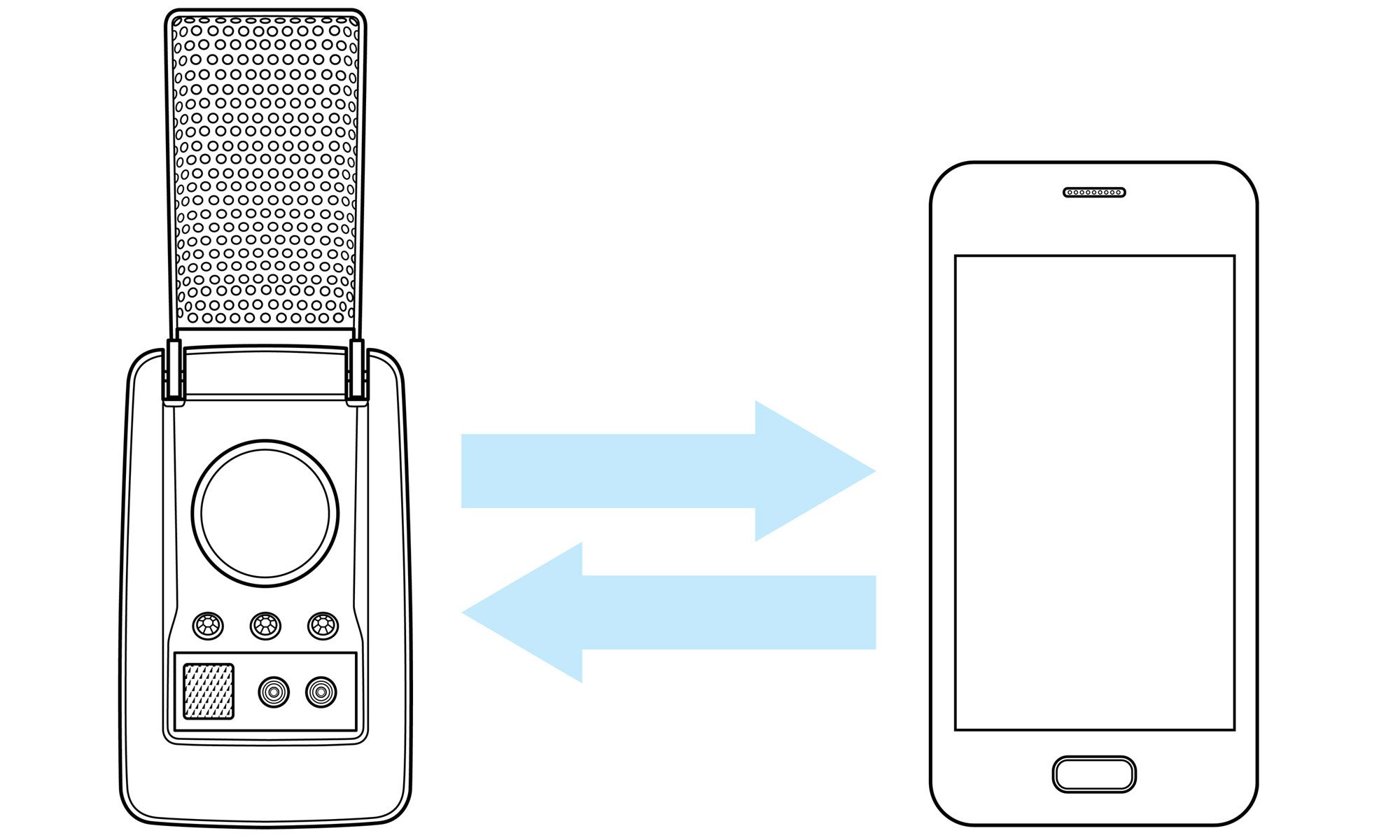
Pairing with a mobile phone is a simple procedure.
Once the Communicator is paired with a phone, just flip open the antenna grille to answer an incoming call.
Press and hold the right-hand button to initiate voice dialling (or to access other functions available via voice-activated assistants such as Siri on iPhones, Google Now on Android or Cortana on Windows phones).
Double-click the right-hand button to pause and play music.
20 authentic Star Trek voice clips and Communicator sound FX can be accessed at any time via the right-hand 5-way jog button.

What people are saying about the Communicator
The press
The Verge
The little device was actually designed using one of the original props from Star Trek, and is composed of a combination of pressed metal, aluminum, and textured plastic. Without having actually lived through the 1960s, I thought it felt authentic — weighty and purposeful for people in Starfleet. The grill flips opens with the actual sound effects from the show, and the speaker and transceiver make it look truly like a 23rd century artifact.
The Thrillist
That sound you may have heard earlier today? The excited sobs of Trekkies everywhere when they saw that this bad boy is soon going to be a reality. The Wand Company just threw down a certified replica of the iconic Star Trek Original Series Communicator. A fully-functioning certified replica. Yeah!
Gizmodo
This Bluetooth-equipped Star Trek Communicator is going to enable my bad habits even further—and my friends will hate me for it. Created by The Wand Company, a toy outfit that has a penchant for designing nerd treasure with actual real-world function.
Pocket Now
Here’s where things get intense. The Wand Company wasn’t content merely to kick out a slightly refined version of the communicator toys we’ve seen for years; rather, building on the reproduction expertise it demonstrated with its earlier phaser remote control, it’s made the Star Trek Bluetooth Communicator a fully-fledged, museum-quality replica.
The Trek Collective
…it is also probably the best reproduction of that prop ever offered.
Our customers
“It’s so great that you build all that stuff from the original show!!! Thanks for that!! I will buy some!”
“I wish I could high five each and everyone one of you at The Wand Company you all def deserve!”
“This is absolutely amazing. I just got through studying it. Heck, even the diagram is fantastic. I can’t imagine how great it will be to actually hold one of these in my hands.”
“I am very much looking forward to this, if it works like I hope it works, I may never talk directly on my phone again!”
“I’ve never even watched Star Trek and I honestly want this. Looks awesome.”
“This is awesome, Wand Company! Have wanted one of these for a long time and this was a great surprise when I came across it today! Every one of your products so far has been great! Keep it up!”
“I’ve been involved in the Star Trek prop-building community for a long time, and this is the holy grail. Commercially available “replicas” made up to this point have been pretty lackluster…and come in at many times the price of this and had no practical functionality at all.”
“This will look fantastic sitting next to my Phaser can’t wait.”
“Wow. You are spoiling us now….but THANK YOU!!! An already top quality product just got better!”
A Communicator that really works is a dream come true for fans who have waited 50 years for the function of this iconic prop to be realised.
Ever since James Tiberius Kirk flipped that gold-coloured antenna grille, called the Enterprise’s Chief Engineer orbiting 1000 kilometres above him, and asked to be beamed up, every Star Trek fan, in fact pretty much every science fiction fan, has wistfully dreamed of having a working Communicator of their own.
The Communicator didn’t just excite fans with a sense of what the future might hold for them: it actually inspired engineers to boldly go and create that future. Martin Cooper, the engineer working at Motorola credited with creating the world’s first mobile phone in 1973, said it was Kirk’s iconic prop that inspired him to create it.
The mobile phone has changed the way that the human race interacts. Mobile phones now dominate one-to-one and one-to-many communications; but still nothing can compare with the utter magic of putting yourself into the mindset of an intrepid 23rd century Starfleet landing party and flipping that golden antenna grille to answer an incoming call with the classic Communicator chirp, or speaking through the Communicator to your ship’s computer to ask it to dial and connect you with one of your friends.
For all those fans that dreamed, now at last the wait is over – owning is believing!
The Communicator has sold out
Unfortunately you can’t currently purchase a new Communicator as the last production batch has sold through. We hope we will be able to make more in the future. If we do we will announce that on our social channels.
Frequently-asked questions
Look down this list of frequently-asked questions to find answers that will help you if you are thinking of buying a Communicator and want to learn more about how it works.
Is the Communicator a walkie talkie?
No, the Communicator is a Bluetooth enabled handset. This means that the Communicator can wirelessly send and receive audio to and from a Bluetooth enabled mobile phone (or Bluetooth enabled music player) within a range of about five metres. Therefore, in order to use the Communicator to talk to other people, you will need a Bluetooth enabled mobile phone with which the Communicator will have to be paired and connected.
Can I receive phone calls on the Communicator?
Yes, provided you have a Bluetooth enabled mobile phone and the Communicator is paired with it, within range and connected to it.
When a call comes in, the Communicator will play the hailing beep and flipping open the antenna grille will answer the call.
Can I make phone calls on the Communicator?
The Communicator does not have a numeric keypad or graphical display, so calls may only be initiated via the Communicator if it is paired with and connected to a mobile phone that supports voice dialing from a hands-free Bluetooth headset, or by using the ‘last number redial’ function (see below).
To make a call:
Single click the right button to initiate voice dialing.
Once voice dialing is initiated the Communicator will play speech prompts and confirmation tones from your mobile through the Communicator’s speaker and your mobile phone will use the Communicator’s microphone.
For some phones, an internet connection is required for voice dialing.
IMPORTANT: Please check your mobile phone’s user manual to find out if your mobile phone supports voice dialing from a Bluetooth headset, and best way to activate and use it. There are some mobile phones that can only use voice dialing if a key is pressed on the mobile phone to initiate voice dialing. You will not be able to use a phone like this for voice dialing from the Communicator. Also, identical mobile phones may handle remote voice dialing differently depending on what version of operating system software they currently have installed.
Last number redial
Press and hold the right button for last number redial. This can be useful where your mobile phone doesn’t support remote voice dialing, but you would still like to make a call from your Communicator.
What batteries does the Communicator use?
The Communicator has a built-in rechargeable lithium polymer power cell that is recharged via the USB cable supplied with the Communicator. (Any good quality USB to micro-USB cable may also be used). The Communicator handset is charged by placing it on the charging base and held in place by magnetic catches.
Is the Communicator a "screen accurate" replica?
For most users the answer is a definite “Yes!”. We have spent thousands of hours and taken great care to make this Communicator replica as accurate as possible to the last known screen-used hero prop that Shatner and Nimoy used in the original series of Star Trek. In order to make it so accurate we took high-resolution 3D structured light scans of the “Alpha” original hero prop. To complement the “Alpha” scans we took numerous photographs and measurements, 3D laser scanned the “Epsilon” static screen-used prop, and took castings from (and weighed the components of) the “Zeta” static prop. We also made use of HeroComm.com’s extensive access to samples of authentic original materials, which were kindly loaned to us to make sure that our Communicator not only followed the data of the original accurately, but also captured the nuances of the original prop’s intention.
However, in order to make the Communicator manufacturable and more affordable, and to iron out some of the original’s inconsistencies, we have had to make some slight changes, and as such, this replica may be considered to be an idealised version of the original hero prop.
Materials
The original hero prop was made from a range of different materials including thermoformed Kydex sheet material, brass, and aluminium. In order to keep the cost as reasonable as possible we have used the nearest equivalent material that is suitable for modern manufacturing methods. Where metal was used in the construction of the hero prop, we have used metal in the Communicator replica.
The Main Housing
The hero prop’s main housing was made by thermoforming a sheet of Kydex material over a specially shaped tool. The Kydex had a particular pattern designed to replicate a pigskin texture. Due to the process, the texture stretched slightly at the sides, where the sheet was drawn down over the steeper draft angles of the housing. Our Communicator could not be made using thermoforming due to the need for internal fixings, so as a result our replica’s housing is made from injection-moulded ABS. However, the Kydex pattern was carefully reproduced using an advanced 3D laser etching process to create the pattern on the surface of the mould tool. One of the benefits of using this process is that we were able to measure the distortion of the original sheet material and recreate it on the texture of the injection-moulded part.
The Antenna Grille
The hero prop’s antenna grille was made by forming a sheet of perforated brass to give it its distinctive rounded-corner box shape. This was then soldered onto a brass wire that was glued into the turned brass hinge axle. For our Communicator for the purposes of robustness we have used steel for the grille and the supporting wire and coated it in a gold metallic finish. The hinge axle is die cast zinc.
The Mid-Plate
The hero prop’s mid-plate was a simple shape cut out of a sheet of aluminium. While our Communicator’s mid-plate looks identical on the outside, inside the Communicator it has a complex design that is a structural element, providing a fixing for many internal parts and a strong hinge stop for the antenna grille. As a result our Communicator’s mid-plate is manufactured in die-cast zinc, causing the overall weight of our replica to be around 27 grams heavier than the screen-used “Alpha” hero prop.
The Moiré Bezel
In the hero prop, where aluminium was used for the bezel, we have copied this exactly using CNC-machined aerospace-grade aluminium. On the “Alpha” hero prop, the bezel was mounted not quite centrally onto the top of the housing – we have corrected this imperfection for our product.
The Jewels
The hero prop’s jewels were Swarovski jewels mounted on the upturned ends of vacuum metallised slot car wheel hubs. The left and right jewels were sputter coated in gold to give them an iridescent AB (Aurora Borealis) look. The hero prop jewels did not light up and were prone to falling off. Our Communicator’s jewels do light up and need to be fixed permanently in place. The replica jewels are injection moulded – with facets underneath to catch the light. The left and right jewels are also sputter coated in a gold layer to give them that authentic iridescent AB (Aurora Borealis) appearance. Light pipes connect the jewels to LEDs inside the main housing, and chromium-plated injection-moulded mounts house and fix the jewels permanently in position. In the “Alpha” prop, the jewels were not evenly spaced across the housing – this was not an intentional aspect of the design so we have corrected the spacing for our product.
The Buttons
The hero prop had vacuum-metallised slot car wheel hubs as buttons. The original hubs were injection moulded in yellow plastic that was coated in a very thin layer of shiny metal. As a result it wore off during handling, revealing the plastic underneath. Our Communicator uses specially moulded buttons that are more heavily plated (with true chrome electroplating) and will be much less prone to surface wear.
Moiré winder
The “Alpha” hero prop’s moiré pattern rotated, turned by a pocket watch mechanism inside the prop. This was wound up through a brass tube that poked out of the main housing at the front under the mid-plate. After careful consideration,we decided that this aspect of the hero prop was not intended to be shown on screen and as a result was removed from our design. To make room inside the Communicator for the Bluetooth wireless components battery and speaker, the moiré screen is rotated by a miniature stepper motor.
Can I use any USB cable to power up the charging stand?
Yes. The Communicator is supplied with with a USB charging cable, but any good quality micro-USB cable may be used to power the charging stand and thus charge up the Communicator.



